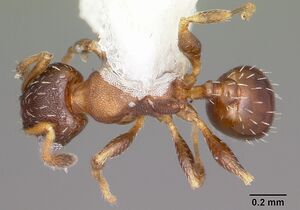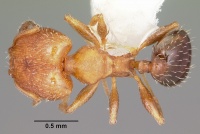Pheidole constipata
| Pheidole constipata | |
|---|---|

| |
| Scientific classification | |
| Kingdom: | Animalia |
| Phylum: | Arthropoda |
| Class: | Insecta |
| Order: | Hymenoptera |
| Family: | Formicidae |
| Subfamily: | Myrmicinae |
| Tribe: | Attini |
| Genus: | Pheidole |
| Species: | P. constipata |
| Binomial name | |
| Pheidole constipata Wheeler, W.M., 1908 | |
The type series was taken from several colonies found under stones by Wheeler (1908h) at Austin and New Braunfels, Texas. In addition Stefan Cover (unpublished notes) found several colonies and colony fragments nesting under stones at Pedernales Falls State Park, Blanco Co., Texas, in juniper and juniper-oak-mesquite woodland. Winged males were found by W. M. Wheeler on 27 May 1903. This species, if truly local, may be threatened by the advance of dense populations of the red imported fire ant (Solenopsis invicta) into the Texas hill country. Cover found it only in areas not yet occupied by fire ant colonies. (Wilson 2003)
Identification
See the description in the nomenclature section.
Keys including this Species
Distribution
Known only from the vicinity of Austin and New Braunfels, central Texas. (Wilson 2003)
Latitudinal Distribution Pattern
Latitudinal Range: 30.307978° to 23.71527°.
| North Temperate |
North Subtropical |
Tropical | South Subtropical |
South Temperate |
- Source: AntMaps
Distribution based on Regional Taxon Lists
Nearctic Region: United States (type locality).
Distribution based on AntMaps
Distribution based on AntWeb specimens
Check data from AntWeb
Countries Occupied
| Number of countries occupied by this species based on AntWiki Regional Taxon Lists. In general, fewer countries occupied indicates a narrower range, while more countries indicates a more widespread species. |

|
Estimated Abundance
| Relative abundance based on number of AntMaps records per species (this species within the purple bar). Fewer records (to the left) indicates a less abundant/encountered species while more records (to the right) indicates more abundant/encountered species. |

|
Biology
Association with Other Organisms
 Explore: Show all Associate data or Search these data. See also a list of all data tables or learn how data is managed.
Explore: Show all Associate data or Search these data. See also a list of all data tables or learn how data is managed.
- This species is a host for the phorid fly Microselia texana (a parasitoid) (Quevillon, 2018) (encounter mode primary; direct transmission; transmission outside nest).
Castes
Worker
Minor
Images from AntWeb
   
| |
| Worker. Specimen code casent0104786. Photographer April Nobile, uploaded by California Academy of Sciences. | Owned by UCDC, Davis, CA, USA. |
Nomenclature
The following information is derived from Barry Bolton's Online Catalogue of the Ants of the World.
- constipata. Pheidole constipata Wheeler, W.M. 1908e: 468 (s.w.q.m.) U.S.A. Subspecies of floridana: Smith, D.R. 1979: 1370. Revived status as species: Wilson, 2003: 402.
Unless otherwise noted the text for the remainder of this section is reported from the publication that includes the original description.
Description
From Wilson (2003): An unusual member of the flavens group distinguished from other species of the genus as follows.
Major: yellow; mesosomal pilosity very sparse, consisting mostly of several clavate hairs; similar hairs present on occiput and waist; humerus raised slightly and subangulate; rugoreticula present between each eye and antennal fossa, and on the edges of the humeri; postpetiole from above elliptical.
Minor: mesosomal pilosity very sparse, consisting mostly of several clavate hairs; similar hairs present on occiput and waist; propodeal spines directed backward; postpetiole from above elliptical; head and mesosoma almost entirely foveolate.
MEASUREMENTS (mm) Lectotype major: HW 0.72, HL 0.80, SL 0.42, EL 0.12, PW 0.42. Paralectotype minor: HW 0.44, HL 0.48, SL 0.42, EL 0.10, PW 0.30.
COLOR Major: concolorous reddish yellow.
Minor: mesosoma, waist, and appendages dark yellow; head and gaster yellowish brown.
Figure. Upper: lectotype, major. Lower: paralectotype, minor. Scale bars = 1 mm.
Type Material
TEXAS: Austin, col. W. Wheeler. Museum of Comparative Zoology and American Museum of Natural History - as reported in Wilson (2003)
Etymology
L constipata, crowded or pressed together, allusion unknown, possibly to the compressed nature of the clavate hairs. (Wilson 2003)
References
- Wheeler, W. M. 1908h. The ants of Texas, New Mexico and Arizona. (Part I.). Bull. Am. Mus. Nat. Hist. 24: 399-485 (page 468, soldier, worker, queen, male described)
- Wilson, E. O. 2003. Pheidole in the New World: A dominant, hyperdiverse ant genus. Harvard University Press, Cambridge, MA. (page 402, fig. major, minor described)
References based on Global Ant Biodiversity Informatics
- Gregg R. E. 1959. Key to the species of Pheidole (Hymenoptera: Formicidae) in the United States. Journal of the New York Entomological Society 66: 7-48.
- McDonald D. L., D. R. Hoffpauir, and J. L. Cook. 2016. Survey yields seven new Texas county records and documents further spread of Red Imported Fire Ant, Solenopsis invicta Buren. Southwestern Entomologist, 41(4): 913-920.
- O'Keefe S. T., J. L. Cook, T. Dudek, D. F. Wunneburger, M. D. Guzman, R. N. Coulson, and S. B. Vinson. 2000. The Distribution of Texas Ants. The Southwestern Entomologist 22: 1-92.
- Wheeler W. M. 1908. The ants of Texas, New Mexico and Arizona. (Part I.). Bulletin of the American Museum of Natural History 24: 399-485.
- Wheeler, G.C. and J. Wheeler. 1985. A checklist of Texas ants. Prairie Naturalist 17:49-64.
- Wilson, E.O. 2003. Pheidole in the New World: A Dominant, Hyperdiverse Genus. Harvard University Press


